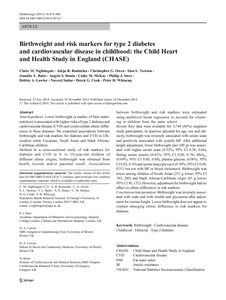Nightingale, CM;
Rudnicka, AR;
Owen, CG;
Newton, SL;
Bales, JL;
Donin, AS;
McKay, CM;
Steer, PJ;
Lawlor, DA;
Sattar, N;
et al.
Nightingale, CM; Rudnicka, AR; Owen, CG; Newton, SL; Bales, JL; Donin, AS; McKay, CM; Steer, PJ; Lawlor, DA; Sattar, N; Cook, DG; Whincup, PH
(2015)
Birthweight and risk markers for type 2 diabetes and cardiovascular disease in childhood: the Child Heart and Health Study in England (CHASE).
Diabetologia, 58 (3).
pp. 474-484.
ISSN 1432-0428
https://doi.org/10.1007/s00125-014-3474-7
SGUL Authors: Cook, Derek Gordon McKay, Catherine Mary Nightingale, Claire Owen, Christopher Grant Rudnicka, Alicja Regina Whincup, Peter Hynes Donin, Angela
![[img]](https://openaccess.sgul.ac.uk/107330/1.hassmallThumbnailVersion/Birthweight_risk_markers_type_2_diabetes_childhood_CHASE.pdf)  Preview |
|
["document_typename_application/pdf; charset=binary" not defined]
Published Version
Download (241kB)
| Preview
|
Abstract
AIMS/HYPOTHESIS: Lower birthweight (a marker of fetal undernutrition) is associated with higher risks of type 2 diabetes and cardiovascular disease (CVD) and could explain ethnic differences in these diseases. We examined associations between birthweight and risk markers for diabetes and CVD in UK-resident white European, South Asian and black African-Caribbean children.
METHODS: In a cross-sectional study of risk markers for diabetes and CVD in 9- to 10-year-old children of different ethnic origins, birthweight was obtained from health records and/or parental recall. Associations between birthweight and risk markers were estimated using multilevel linear regression to account for clustering in children from the same school.
RESULTS: Key data were available for 3,744 (66%) singleton study participants. In analyses adjusted for age, sex and ethnicity, birthweight was inversely associated with serum urate and positively associated with systolic BP. After additional height adjustment, lower birthweight (per 100 g) was associated with higher serum urate (0.52%; 95% CI 0.38, 0.66), fasting serum insulin (0.41%; 95% CI 0.08, 0.74), HbA1c (0.04%; 95% CI 0.00, 0.08), plasma glucose (0.06%; 95% CI 0.02, 0.10) and serum triacylglycerol (0.30%; 95% CI 0.09, 0.51) but not with BP or blood cholesterol. Birthweight was lower among children of South Asian (231 g lower; 95% CI 183, 280) and black African-Caribbean origin (81 g lower; 95% CI 30, 132). However, adjustment for birthweight had no effect on ethnic differences in risk markers.
CONCLUSIONS/INTERPRETATION: Birthweight was inversely associated with urate and with insulin and glycaemia after adjustment for current height. Lower birthweight does not appear to explain emerging ethnic difference in risk markers for diabetes.
Statistics
Item downloaded times since 03 Mar 2015.
Actions (login required)
 |
Edit Item |



